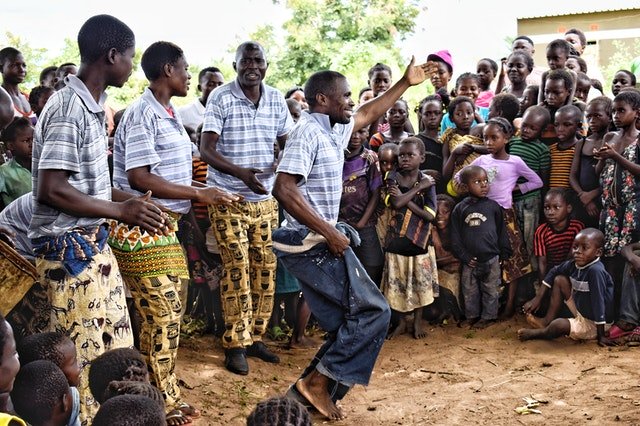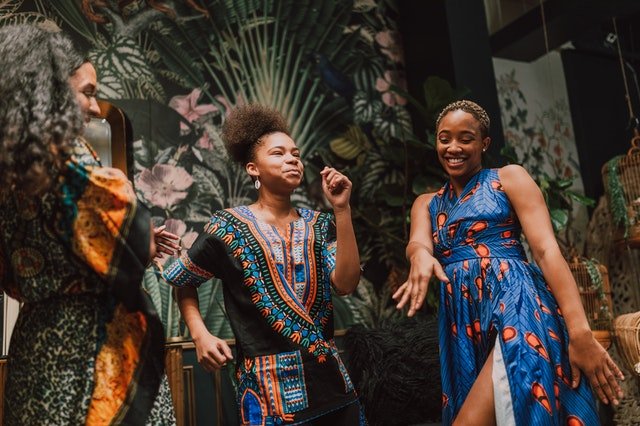DANCING - 5 Reasons Why its Good for your Health

Do you like dancing? How long is it since you danced? Do you know the health benefits of dancing regularly?
There are many global civilisations that have its inherent cultural values embedded in its dance forms - in fact, dance is a very important expression of its history too. Whether it be the traditional folk dances of Ireland and Switzerland; the Russian Ballet to the Argentinian tango; or, the Cuban Salsa and the famous Brazilian Samba dance routines.
Yet, they all have a common thread attached to their dancing activity. That being, the 'intent to express or communicate emotion, feelings, or ideas'
Furthermore, dance doesn't have to be structured or confined to an elaborate theatre setting with an audience, it can also be a ritual dance - such as those performed by the Hindu Cultures or praise dancing as defined by the African Americans in Pentecostal churches.
Also, another significant factor surfaces amongst the dancing circles - and that is; that it signifies joy, spiritual connection, or celebration. Although much of the research tends to outline the many shorter term health benefits of Dancing as being a healthy exercise and how it can help burn up some calories and enhance mood. It also emphasises a 'sense of happiness.'
So, let's delve deeper into the reasons why dancing is good for your health.

Reason 1. Improves Creativity
Evidence exists that dancing improves creativity and even reading skills. According to academic Psychologist Dr Peter Lovatt - whom I might add, is also a professional dancer himself, and the head of the Dance Psychology Lab. within the University of Hertfordshire, in England - he states:
"Dancing is one of the most natural things we can do and it has amazing impact on our thinking and thought processes; as well as our ability to learn" [1]
Reason 2. Improves Brain Health
Besides Dance' being an effective type of exercise which has the inner ability to increase your heart rate and give your muscles a work-out. It also releases certain brain chemicals that can help with symptoms of depression and anxiety to helping you escape any repetitive negative thoughts and mind worries. Like education, participation in mentally engaging activities lowers the risk of dementia by improving these neural qualities.
In considering a 21-year study of senior citizens, 75 and older, that was led by a research team at the Albert Einstein College of Medicine in New York City, and then published in the New England Journal of Medicine.
Their report findings were focussed on learning about the effects of recreational activities on mental activity in aging. These included both physical activities (e.g. cycling, golf, swimming, walking exercise, housework, and tennis) and mental activity (e.g. reading books, writing for pleasure, playing cards or a musical instrument to doing crossword puzzles) and then to follow on and monitor rates of dementia, including Alzheimer's disease.
Remarkably, the results inclusive of both the physical and mental activities concluded that Dancing frequently (76%) had the greatest risk reduction of any activity studied, cognitive or physical and to offer protection against dementia. Second was Reading (35%) and doing Crosswords puzzles at least 4 days a week. (47%). Even more enlightening was that cycling, playing golf, or swimming concluded 0%. [2]
Reason 3. Improves Psychological Health
Here, I refer to Clinical Associate Professor of Psychiatry and Behavioural Sciences Brett Steenbarger; as, he has conducted intense studies on the Psychology of Dance and emphasises the point that moving the body can help to transform the mind. He also states:
"Dance becomes a means of connecting to broader meanings and deeper emotional experiences—particularly ones associated with positivity' and eases depressive moods and anxiety." [3]
Other research studies - such as the one conducted by North Dakota’s Minot State University found that the Latin-style dance program known as Zumba' improves mood and certain cognitive skills, such as visual recognition and decision-making. Research also shows that dance helps reduce stress; increases levels of the feel-good hormone serotonin; and, helps develop new neural connections, especially in regions involved in executive function, long-term memory, and spatial recognition. [4]
Reason 4. Improves Physical Health
Besides the huge psychological benefit that regular dance can give, it can also improve balance, mobility, flexibility and coordination. In considering some of the Physiologic research studies, there's a clear thread in terms of it demonstrating how dance can help to build muscle and bone, reduce body fat, lower blood pressure, and even improve the ratio of 'good' to 'bad' cholesterol.
According to Beverly Merz, an Executive Editor with Harvard Women's Health Watch in the U.S. she points out that studies have indicated that if you dance regularly and master its specific movements - greater improvements in memory and problem-solving will occur, even more so than walking does. [5]
Reason 5. Improves Social Interaction & Bonding
The final reason why dancing is good for your health, is that improves social activity and interaction, plus it leads to bonding. This is a very powerful benefit that can improve the social wellbeing of people of all ages from children to the aged care sector.
For example, many studies such as the one published in the Scientific American by Jason Goldman, show that dancing at parties and in groups encourages social bonding; allows people to meet new people and make friends; and, helps to increase self-esteem and self-confidence.
He also refers to a quote made by social psychologist Paul Reddish, at the Victoria University of Wellington in New Zealand who states: “there is something special about matching the same behaviours at the same time.” Although, he says that the jury is still out regarding the role of endorphins in social bonding, it still remains clear that mirroring others—whether in dance, in sports or even in conversation - helps to foster friendships.
“We should all dance more,” Tarr says. [6]

Conclusion
Dancing, has the lead upon many of the common everyday physical and mental activities. Why?
Because, it integrates several brain functions at once (e.g. kinaesthetic, rational, musical, and emotional) that other activities don't. As a consequence, this has a subsequent ripple effect - in that, it further increases neural connectivity within the brain. Being mindful too, that increasing any activities that require split-second rapid-fire decision making can be very fruitful.
Hence, the concluding message is...
'DANCE OFTEN'

Article Refs:
1. Lovett, P. (2011). 'Dance, thinking, hormones.' TED Talk video cited online at https://www.youtube.com/watch?v=-kCZZp3u_xE TEDxOslo - 23 June 2011.
2. Verghese, J., et.al. (2003). 'Leisure activities and the risk of dementia in the elderly.' New England Journal of Medicine; June 19; Vol. 348, (25), pp. 2508-16.
3. Steenbarger, B. (2020).'Moving The Body, Transforming The Mind: The Psychology of Dance' Forbes. SUNY Upstate Medical University in Syracuse, NY. Oct 31, 2020.
4. Edwards, S. (2015).'Dancing and the Brain' Harvard Medical School. 'Millions of Americans dance, either recreationally or professionally.' Article cited at https://hms.harvard.edu/news-events/publications-archive/brain/dancing-brain.
5. Merz, B. in Harvard Health Publishing (2016). 'Let’s dance! Rhythmic motion can improve your health.' Exercise and Fitness. Cited online article at https://www.health.harvard.edu/blog/lets-dance-rhythmic-motion-can-improve-your-health-201604219468. April 21, 2016.
6. Goldman, J. G. (2016). 'Why dancing leads to bonding -Both exertion and synchronicity play a role in the social effects of dance.' Scientific American, Behaviour & Society, May 1, 2016.
Image Credits:

